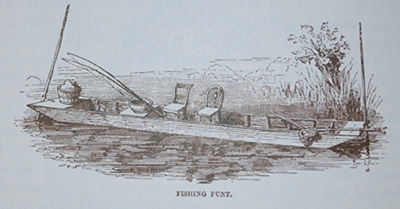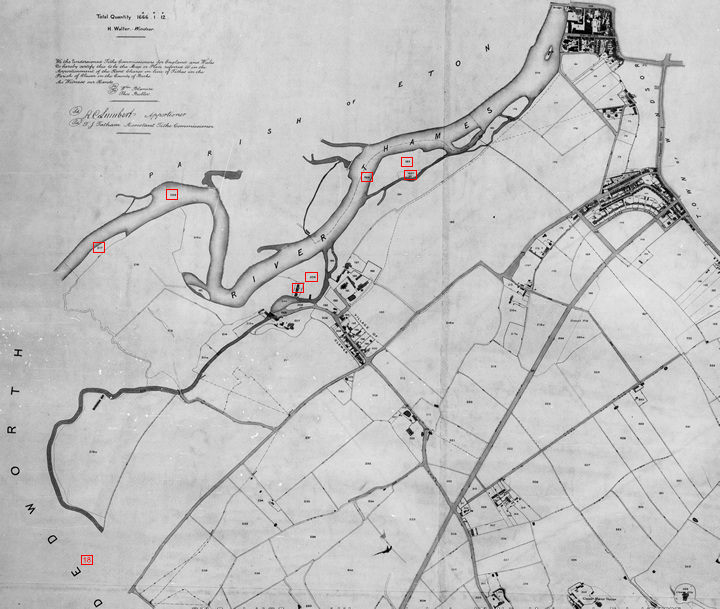| William Finmore | |
|
Memorabilia
|
William Finmore was born on 15 April 1798 at Bray, Berkshire, and married Mary House on 2 December 1819 in New Windsor. They had five children between 1820 and 1834; George, who became a miller; and four daughters: Ann Edwards, Mary Ann, Eliza and Mary. The family seems to have lived in Clewer up to and beyond the 1851 census, but at the time of the 1841 census William was visiting his uncle, Richard Griffin, at Bray, higher up the Thames. Maybe his business activities took him there since his working life was closely linked to long stretches of the river and its environs. The 1839 Tithe Commissioners’ records list several plots of land which William rented at that time and they were all just upstream from Windsor, mostly in the parish of Clewer. They are marked in red on the map below.
This extract from the tithe map for the parish of Clewer shows Windsor with its bridge across the Thames at the top right corner and the village of Clewer in the centre. Plots 183 and 183a contain the small island near to Windsor and there William cultivated osiers to sell for basketwork. The island, or eyott as described in the tithe records, is now known as Baths Island in memory of its former use for bathing but previously was called Deadwater Ait (another spelling of the word, as is eyot). In 1849 a railway bridge was built across the Thames at this point, with the island supporting a viaduct. Queen Victoria is supposed to have demanded that male swimmers move out of view of the trains crossing on the bridge. The two plots nearest Clewer village, 209 and 210, and the plot 217 further up-stream are all sited on a much larger island in the Thames which now hosts the Royal Windsor Racecourse. They consist of osiers, meadow and rough ground. In the bottom left corner of the map is the approximate position of plot 18, another meadow field, but this time in the hamlet of Dedworth.
The 1834 Post Office Directory entry for Clewer listing William Finmore as an osier dealer The final red boxes, both numbered 569, represent the limits of a stretch of the Thames itself. William had the right to work these 22 acres of river as a fishery and in the 1841 and 1851 censuses he is described as a fisherman. A further string to his financial bow would have been supervising visiting anglers as described by a noted natural historian named Francis Buckland. In his book "Curiosities of Natural History" the fourth chapter is entitled "Fish and Fishing" and it is here that Finmore is introduced to the reader. Given his age and pedigree this must surely refer to William; no other candidates appear in local records at the time. We well remember, one fine day in August last, going out on a gudgeon-fishing expedition. A luxurious dog-cart carried us quickly to Surley Hall, well known to Etonians. There we found the Charon of this part of the river, Finmore by name, waiting for us in his punt. This old man’s family has had the fishing of the water for more than a hundred years; and the old man himself knows every hole and patch of weeds in the river just about Windsor as well as a Londoner does the shops of Regent Street. This is followed by a description of how the expedition is organised. In the punt were placed three chairs and three fishing-rods, two punt poles with sharp iron spikes on their ends, called in these parts "rypecks": why or wherefore they have received this name we cannot ascertain; lastly an enormous iron rake. 
An appropriate illustration from "The Book of the Thames", first published in 1859.
Fishing at this time appears to be a very leisurely pastime for the gentleman fisherman, according to the next section.
It is quite contrary to the rules to put on one's own bait, to alter one's own float, to take the captured fish of the hook: all is done by Charon, who not unfrequently has quite enough to do. Everything prepared, the boat is pushed out into the middle of the river, the two rypecks are fixed firmly into the ground at the bottom, and the boat is fastened to them across the stream. Charon, or Finmore, does find time to give his opinion on fishing techniques, Thames lore and the like. He tells of hearing otters barking when he is "out in the grey of the morning, taking up his nets". Then, after a description of how Charon caught the king of the jacks (a young pike) in the autumn of 1855 comes this final story of his exploits. But this is not the only large fish Charon ever caught; it was he who captured the last salmon ever seen in the Thames above London. Forty years have passed since the last of his species, in the Thames, became a victim to the cupidity of man. This poor fish had a favourite hole near Surley Hall, which was at last found out, and his destruction determined upon. Accordingly one day the hole was surrounded with nets on every side, and the fishermen made sure of their prey; but they were mistaken. The salmon discovered suddenly that there was treachery, and, like a brave and wise fish, he made a jump, not into the net,- he was too knowing for that,- but right over it, escaping triumphant, for a time at least. Some days afterwards he returned home to his hole; the nets were again put round him; but this time, on to the cork line of the nets which were in the water, was fastened a net, which remained suspended in the air by a string. Again the salmon made a rush and a jump; he got well over the net in the water, but fell, of course, into the net suspended in the air. He died an inglorious death, but his remains were honoured by becoming “a dainty dish to set before a King;” for he was taken to the King, then residing at Virginia Water, who gave the lucky netter a guinea a pound for his fish; twenty guineas for a few hours’ work! Charon gives his opinion that the salmon are kept away from the Thames not by the steamers and sewage matter in the river but by the drainage from the gas-works.The king in question was either George III or George IV, if the forty years was about right. George IV was apparently a keen angler and spent much time fishing at Virginia Water so perhaps he is the more likely. William Finmore would have been in his twenties at the time.
|
| Top of Page |

